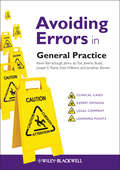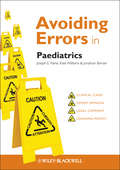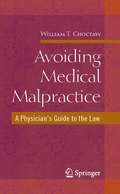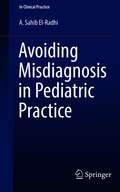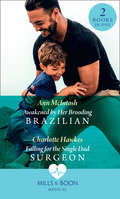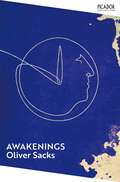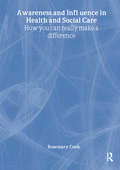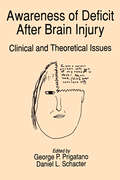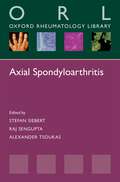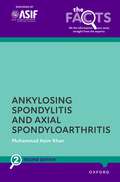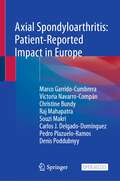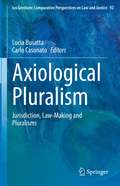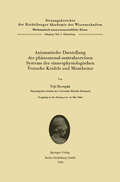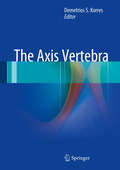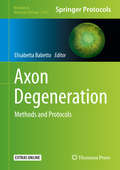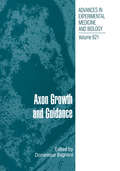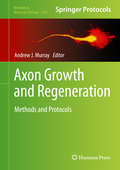- Table View
- List View
Avoiding Errors in General Practice (AVE - Avoiding Errors)
by Kevin Barraclough Jenny du Toit Jeremy Budd Joseph E. Raine Kate Williams Jonathan BonserSome of the most important and best lessons in a doctor’s career are learnt from mistakes. However, an awareness of the common causes of medical errors and developing positive behaviours can reduce the risk of mistakes and litigation. Written for Foundation Year doctors, trainees and general practitioners, and unlike any other clinical management title available, Avoiding Errors in General Practice identifies and explains the most common errors likely to occur in an outpatient setting - so that you won’t make them. The first section in this brand new guide discusses the causes of errors in general practice. The second and largest section consists of case scenarios and includes expert and legal comment as well as clinical teaching points and strategies to help you engage in safer practice throughout your career. The final section discusses how to deal with complaints and the subsequent potential medico-legal consequences, helping to reduce your anxiety when dealing with the consequences of an error. Invaluable during the Foundation Years, Specialty Training and for Consultants, Avoiding Errors in General Practice is the perfect guide to help tackle the professional and emotional challenges of life as a GP.
Avoiding Errors in General Practice (AVE - Avoiding Errors)
by Kevin Barraclough Jenny du Toit Jeremy Budd Joseph E. Raine Kate Williams Jonathan BonserSome of the most important and best lessons in a doctor’s career are learnt from mistakes. However, an awareness of the common causes of medical errors and developing positive behaviours can reduce the risk of mistakes and litigation. Written for Foundation Year doctors, trainees and general practitioners, and unlike any other clinical management title available, Avoiding Errors in General Practice identifies and explains the most common errors likely to occur in an outpatient setting - so that you won’t make them. The first section in this brand new guide discusses the causes of errors in general practice. The second and largest section consists of case scenarios and includes expert and legal comment as well as clinical teaching points and strategies to help you engage in safer practice throughout your career. The final section discusses how to deal with complaints and the subsequent potential medico-legal consequences, helping to reduce your anxiety when dealing with the consequences of an error. Invaluable during the Foundation Years, Specialty Training and for Consultants, Avoiding Errors in General Practice is the perfect guide to help tackle the professional and emotional challenges of life as a GP.
Avoiding Errors in Paediatrics (AVE - Avoiding Errors)
by Joseph E. Raine Kate Williams Jonathan BonserSome of the most important and best lessons in a doctor’s career are learnt from mistakes. However, an awareness of the common causes of medical errors and developing positive behaviours can reduce the risk of mistakes and litigation. Written for junior paediatric staff and consultants, and unlike any other paediatric clinical management title available, Avoiding Errors in Paediatrics identifies and explains the most common errors likely to occur in a paediatric setting - so that you won’t make them. The first section in this brand new guide discusses the causes of errors in paediatrics. The second and largest section consists of case scenarios and includes expert and legal comment as well as clinical teaching points and strategies to help you engage in safer practice throughout your career. The final section discusses how to deal with complaints and the subsequent potential medico-legal consequences, helping to reduce your anxiety when dealing with the consequences of an error. Invaluable during the Foundation Years, Specialty Training and for Consultants, Avoiding Errors in Paediatrics is the perfect guide to help tackle the professional and emotional challenges of life as a paediatrician.
Avoiding Errors in Paediatrics (AVE - Avoiding Errors)
by Joseph E. Raine Kate Williams Jonathan BonserSome of the most important and best lessons in a doctor’s career are learnt from mistakes. However, an awareness of the common causes of medical errors and developing positive behaviours can reduce the risk of mistakes and litigation. Written for junior paediatric staff and consultants, and unlike any other paediatric clinical management title available, Avoiding Errors in Paediatrics identifies and explains the most common errors likely to occur in a paediatric setting - so that you won’t make them. The first section in this brand new guide discusses the causes of errors in paediatrics. The second and largest section consists of case scenarios and includes expert and legal comment as well as clinical teaching points and strategies to help you engage in safer practice throughout your career. The final section discusses how to deal with complaints and the subsequent potential medico-legal consequences, helping to reduce your anxiety when dealing with the consequences of an error. Invaluable during the Foundation Years, Specialty Training and for Consultants, Avoiding Errors in Paediatrics is the perfect guide to help tackle the professional and emotional challenges of life as a paediatrician.
Avoiding Medical Malpractice: A Physician's Guide to the Law
by William ChoctawWritten by an MD/JD, this book offers a unique perspective on medical-legal issues surrounding daily clinical practice. It covers all the essentials and tells the inside secrets of how to avoid cases that cost the medical community millions each year. Readers will learn basic law and the ways laws are interpreted. In addition, the book focuses on the law-medicine-politics triangle and its effect on physicians, the impact of — and issues related to — diversity in medical malpractice, and other essential topics. Physicians who better understand malpractice laws are better clinical decision makers who feel more confident in their ability as doctors.
Avoiding Misdiagnosis in Pediatric Practice (In Clinical Practice)
by A. Sahib El-RadhiThis book discusses the most common symptoms in pediatrics. It is based on best available scientific evidence and up-to-date information. The book also discusses a range of common conditions associated with bacterial and viral infections of the oro-nasal, eye, chest, abdominal and genito-urinary regions. The book helps the clinician to distinguish symptoms andsigns of pediatric diseases to avoid diagnostic errors. Each chapter starts with a list of core messages, and includes tables and figures to focus on the subjects under discussion. The whole text is written in reader-friendly manner. The book is of interest to general pediatricians and doctors in primary care. It is also of interest to students, nurses and other professionals who look after children.
Awakened By Her Brooding Brazilian: A Summer In S�o Paulo (A Summer in São Paulo #1)
by Ann McIntoshThe playboy surgeon – and the shy workaholic!
Awakened By Her Brooding Brazilian / Falling For The Single Dad Surgeon: Awakened By Her Brooding Brazilian (a Summer In São Paulo) / Falling For The Single Dad Surgeon (a Summer In São Paulo) (Mills And Boon Medical Ser. #1)
by Ann McIntosh Charlotte HawkesThe playboy and the workaholic…
Awakening His Shy Vet (Mills & Boon Medical)
by Shelley RiversThey’re looking for a fresh start… …with each other?
Awakening The Shy Nurse / Saved By Their Miracle Baby (Mills And Boon Medical Ser. #1)
by Alison RobertsAwakening the Shy Nurse From stolen kiss to temporary fling! In this Sisters, Medics, Brides story, sensible Annalise has always played it safe. But when she accepts a job as nurse on-board a cruise ship, her guard is instantly disarmed by the ship’s playboy doctor, Hugh Patterson… Saved by Their Miracle Baby Can their son unite them forever? In this Sisters, Medics, Brides story, for surgeon Noah, the premature arrival of his baby son with physiotherapist Abby means embracing fatherhood again much sooner than expected. Can he overcome his painful past and be the man his family deserves?
Awakenings (Pelican Ser.)
by Oliver Sacks'The story of a disease that plunged its victims into a prison of viscous time, and the drug that catapulted them out of it' Guardian Hailed as a medical classic, and the subject of a major feature film as well as radio and stage plays and various TV documentaries, Awakenings by Oliver Sacks is the extraordinary account of a group of twenty patients. Rendered catatonic by the sleeping-sickness epidemic that swept the world just after the First World War, all twenty had spent forty years in hospital: motionless and speechless; aware of the world around them, but exhibiting no interest in it - until Dr Sacks administered the then-new drug, L-DOPA, which caused them, temporarily, to awake from their decades-long slumber.
Awareness and Influence in Health and Social Care: The Epidemiologically Based Needs Assessment Reviews, Gynaecology - Second Series
by Rosemary Cook Alison Davies'This is a book about the skills, habits and behaviours that make people influential. The good news is that influence is not just for 'senior' people or people in specific jobs any more. The old hierarchies are breaking down and 'front line' expertise is valued by policy-makers more than ever before. You can be well-known and influential from anywhere. Anyone can do it - if they are prepared to put some personal effort into it...' This comprehensive, easy-to-read guide covers every kind of influential activity and teaches you how to make the most of every opportunity across all levels. It is the only practical text on the topic, designed specifically for health and social care professionals. The insider information, helpful tips, checklists and developmental exercises throughout aid in application, and top tips from professionals currently influencing different arenas of national policy and practice help give you an edge. This book is ideal for nurses in acute and primary care, including health visitors and midwives. Professionals in social care, allied health and clinical science will also find it invaluable, as will postgraduate health and social care students undertaking development and leadership courses.
Awareness and Influence in Health and Social Care: The Epidemiologically Based Needs Assessment Reviews, Gynaecology - Second Series
by Rosemary Cook Alison Davies'This is a book about the skills, habits and behaviours that make people influential. The good news is that influence is not just for 'senior' people or people in specific jobs any more. The old hierarchies are breaking down and 'front line' expertise is valued by policy-makers more than ever before. You can be well-known and influential from anywhere. Anyone can do it - if they are prepared to put some personal effort into it...' This comprehensive, easy-to-read guide covers every kind of influential activity and teaches you how to make the most of every opportunity across all levels. It is the only practical text on the topic, designed specifically for health and social care professionals. The insider information, helpful tips, checklists and developmental exercises throughout aid in application, and top tips from professionals currently influencing different arenas of national policy and practice help give you an edge. This book is ideal for nurses in acute and primary care, including health visitors and midwives. Professionals in social care, allied health and clinical science will also find it invaluable, as will postgraduate health and social care students undertaking development and leadership courses.
Awareness Of Deficit After Brain Injury: Clinical And Theoretical Issues
by George P. Prigatano Daniel L. SchacterAwareness of Deficit after Brain Injury: Clinical and Theoretical Issues
by George P. Prigatano Daniel L. SchacterThis volume provides, for the first time, multidisciplinary perspectives on the problem of awareness of deficits following brain injury. Such deficits may involve perception, attention, memory, language, or motor functions, and they can seriously disrupt an individual's ability to function. However, some brain-damaged patients are entirely unaware of the existence or severity of their deficits, even when they are easily noticed by others. In addressing these topics, contributors cover the entire range of neuropsychological syndromes in which problems with awareness of deficit are observed: hemiplegia and hemianopia, amnesia, aphasia, traumatic head injury, dementia, and others. On the clinical side, leading researchers delineate the implications of awareness of deficits for rehabilitation and patient management, and the role of defense mechanisms such as denial. Theoretical discussions focus on the importance of awareness disturbances for better understanding such cognitive processes as attention, consciousness, and monitoring.
Axial Spondyloarthritis (Oxford Rheumatology Library)
by Stefan Siebert, Raj Sengupta and Alexander TsoukasAxial spondyloarthritis is the commonest inflammatory arthritis affecting the spine. Typically first presenting to a variety of primary and secondary care professionals, the high global disease burden of this condition has created a need for increased awareness of this condition across a range of rheumatology specialties. A pocketbook aimed at the non-specialist reader Axial Spondyloarthritis is the essential guide to this common condition. Focusing on the practical implications of developments in classification, diagnosis and treatment, this easily accessible text fully covers the broader spectrum of the disease. Concise and fully illustrated, this addition to the Oxford Rheumatology Library covers the history and pathophysiology of axial spondylitis, alongside detailed sections on treatments, complications and manifestations of the condition. With each section supported by a handy key points section, Axial Spondyloarthritis is a useful and constructive resource for any practitioner or trainee encountering this condition.
Axial Spondyloarthritis (Oxford Rheumatology Library)
Axial spondyloarthritis is the commonest inflammatory arthritis affecting the spine. Typically first presenting to a variety of primary and secondary care professionals, the high global disease burden of this condition has created a need for increased awareness of this condition across a range of rheumatology specialties. A pocketbook aimed at the non-specialist reader Axial Spondyloarthritis is the essential guide to this common condition. Focusing on the practical implications of developments in classification, diagnosis and treatment, this easily accessible text fully covers the broader spectrum of the disease. Concise and fully illustrated, this addition to the Oxford Rheumatology Library covers the history and pathophysiology of axial spondylitis, alongside detailed sections on treatments, complications and manifestations of the condition. With each section supported by a handy key points section, Axial Spondyloarthritis is a useful and constructive resource for any practitioner or trainee encountering this condition.
Axial Spondyloarthritis and Ankylosing Spondylitis (The Facts Series)
by Muhammad Asim KhanAnkylosing spondylitis (AS), currently grouped under the term axial spondyloarthritis (axSpA), is a chronic form of arthritis that causes inflammatory back pain and can gradually result in impaired spinal mobility. It can also cause eye inflammation (uveitis), arthritis of limb joints, inflammation at sites of bony attachments of tendons and ligaments (enthesitis), and associated psoriasis and inflammatory bowel disease. No cure has yet been found; however, early diagnosis and proper medical and lifestyle management are very important in reducing the risk of deformity and disability. Written by a leading expert on the subject who himself has been living with AS since age 12, this book provides clear and practical information on the clinical symptoms and signs, underlying causes, genetic predisposition, diagnosis, treatments, and impact on daily life. The combination of scientific knowledge and personal experience results in a unique book which will prove invaluable for patients and their families and friends, as well as allied health professionals and students wishing to know more about the condition. The second edition has been fully updated to cover the tremendous advancements made in the clinical recognition and effective management since the first edition in 2002. It also includes a glossary of medical terms and links to sources of further information to give patients the tools they need to understand and manage the condition effectively.
Axial Spondyloarthritis: Patient-Reported Impact in Europe
by Marco Garrido-Cumbrera Victoria Navarro-Compán Christine Bundy Raj Mahapatra Souzi Makri Carlos J. Delgado-Domínguez Pedro Plazuelo-Ramos Denis PoddubnyyThis open access book provides an overview of the International Map of Axial Spondyloarthritis (IMAS) project -focusing on Europe-, a wide-ranging, multi-disciplinary collaboration between academic groups, Health Care Professionals (HCPs), patient organizations and Novartis. IMAS was conceived to improve knowledge of Axial Spondyloarthritis (axSpA) and raise awareness of its heavy burden globally. By asking more than 2,000 patients across Europe about the impact of axSpA on multiple aspects of their life, the full extent of this disease was investigated from a direct patient perspective. This allowed a unique understanding of how living with axSpA affects the daily lives and well-being of patients, and how this varies between European countries.Axial Spondyloarthritis: Patient-Reported Impact in Europe highlights opportunities for progressing quality patient care to be applied to health services globally. HCPs, policy makers and patients will find this book to be an indispensable resource for improving the understanding of this chronic condition, including patients’ clinical outcomes, the protection of those at risk of psychological distress, and the economic burden on patients and society.
Axiological Pluralism: Jurisdiction, Law-Making and Pluralisms (Ius Gentium: Comparative Perspectives on Law and Justice #92)
by Lucia Busatta Carlo CasonatoThis book analyses the features and functionality of the relationship between the law, individual or collective values and medical-scientific evidence when they have to be interpreted by judges, courts and para-jurisdictional bodies. The various degrees to which scientific data and moral values have been integrated into the legal discourse reveal the need for a systematic review of the options and solutions that judges have elaborated on. In turn, the book presents a systematic approach, based on a proposed pattern for classifying these various degrees, together with an in-depth analysis of the multi-layered role of jurisdictions and the means available to them for properly handling new legal demands arising in plural societies.The book outlines a model that makes it possible to focus on and address these issues in a sustainable manner, that is, to respond to individual requests and technological advances in the field of biolaw by consistently and effectively applying suitable legal instruments and jurisdictional interpretation.
Axiomatische Darstellung des phänomenal-zentralnervösen Systems der sinnesphysiologischen Versuche Keidels und Mitarbeiter (Sitzungsberichte der Heidelberger Akademie der Wissenschaften #1966 / 5)
by Yjrö ReenpääThe Axis Vertebra
by Demetrios S. KorresThe axis (second cervical) vertebra is of special interest owing to its particular anatomy, biomechanics, and position in the spine. Despite this, the role of the axis in the function of the cervical spine and the nature of its involvement in trauma and other pathological conditions are still not completely understood. This book covers all aspects of the axis vertebra and its disorders. Embryologic development, normal anatomy, and biomechanics of the axis and upper cervical spine are first discussed, and imaging appearances explained with the aid of standard radiographs and images obtained using advanced techniques. Congenital anomalies, fractures, infections, and tumors (benign and malignant) are then discussed in depth in individual sections. The book is based on the personal experience and expertise of the contributing authors, enhanced by up-to-date information drawn from the literature, and will appeal to a range of practitioners.
Axon Degeneration: Methods and Protocols (Methods in Molecular Biology #2143)
by Elisabetta BabettoThis book is a collection of classical as well as innovative methods used to investigate axon degeneration with a particular focus on addressing the common challenges encountered while performing these procedures. Particular attention is devoted to the study of axon loss in several model organisms, as each poses unique challenges and provides powerful advantages. Written for the highly successful Methods in Molecular Biology series, chapters include introductions to their respective topics, lists of the necessary materials, step-by-step, readily reproducible laboratory protocols, and tips on troubleshooting and avoiding known pitfalls. Authoritative and practical, Axon Degeneration: Methods and Protocols is an ideal guide for facilitating the application and further development of these protocols, which will help the scientific community tackle important questions regarding axon degeneration.Chapters 2, 3, and 20 are available Open Access under a Creative Commons Attribution 4.0 International License via link.springer.com.
Axon Growth and Guidance (Advances in Experimental Medicine and Biology #621)
by Dominique BagnardThis book proposes an updated view of the current knowledge of the molecular and cellular mechanisms ensuring axon growth and guidance. The introductory chapter will remind the readers of all the features of a growth cone and the mechanisms controlling its growth. From there, one enters a fabulous journey with a growth cone, a Tom Thumb story filled with molecular encounters and complex interactions leading to one of the most fantastic developmental achievements: the nervous system wiring.
Axon Growth and Regeneration: Methods and Protocols (Methods in Molecular Biology #1162)
by Andrew J. MurrayAxon Growth and Regeneration: Methods and Protocols brings together a diverse set of techniques for the study of the mechanisms underlying central nervous system axon growth, consequently providing a resource that will aid in the development of repair strategies. After an introductory section, this detailed volume continues with sections focusing on axon growth in vitro, providing a range of protocols that can be used to examine intracellular signalling pathways, axonal responses to extracellular factors and methods for quantifying outgrowth. The next section provides protocols for inducing experimental injury in vivo as well as some highly promising protocols for promoting regeneration, which segues into the final section highlighting a series of protocols that can be used to monitor the extent of axon regeneration in vivo, ranging from tract tracing to in vivo imaging and functional recovery. As a book in the Methods in Molecular Biology series, chapters contain introductions to their respective topics, lists of the necessary materials and reagents, step-by-step, readily reproducible laboratory protocols and tips on troubleshooting and avoiding known pitfalls.Practical and reliable, Axon Growth and Regeneration: Methods and Protocols aims to serve researchers studying axon regeneration with a significant set of diverse tools, vital for moving on to the next generation of exciting new discoveries in the field.
